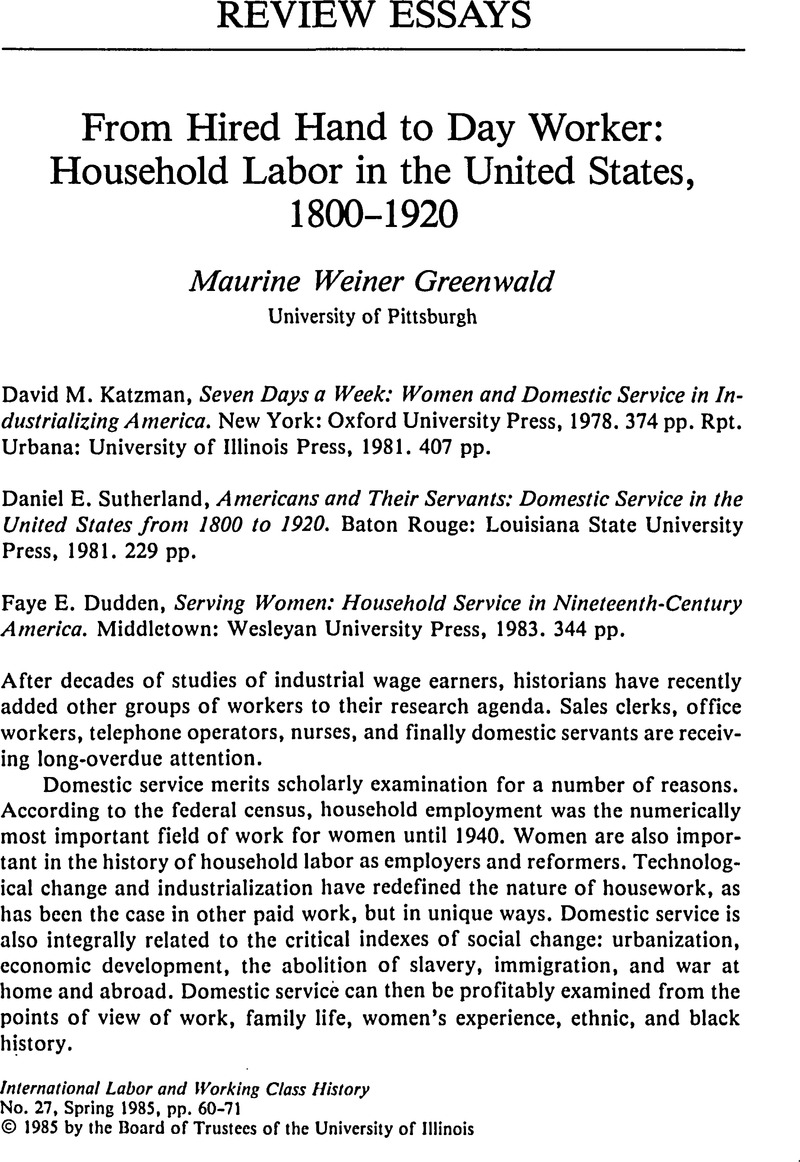No CrossRef data available.
Published online by Cambridge University Press: 16 October 2009

1. For some census data on domestic service in Italy, see Tilly, Louise A., “Comment on Yans-McLaughlin and Davidoff,” Journal of Social History 7 (Summer 1974): 453–54.CrossRefGoogle Scholar
2. Diner, Hasia, Erin's Daughters in America: Irish Immigrant Women in the Nineteenth Century (Baltimore, 1983), 30–42, 70–105Google Scholar. Dudden argues that the different responses of ethnic groups to the market for women's work “reflected differences in traditional family roles and culture as well as in attitudes toward or strategies for the process of migration itself” (63). Unfortunately, she does not apply the generalization to specific groups. See also Steinberg, Stephen, “Why Irish Became Domestics and Italians and Jews Did Not,” in The Ethnic Myth: Race, Ethnicity, and Class in America (Boston, 1982), 151–68Google Scholar. Steinberg emphasizes only the demographic character of the migration of the three groups. For a discussion of Japanese women in domestic service, see Glenn, Evelyn Nakano, “The Dialectics of Wage Work: Japanese-American Women and Domestic Service, 1905–1940,” Feminist Studies 6 (Fall 1980): 432–71.CrossRefGoogle Scholar
3. Sangster, Joan, “Finnish Women in Ontario, 1890–1930,” Polyphony 3 (Fall 1981): 46–54Google Scholar. My thanks to David Montgomery for telling me about this article.
4. Poverty and Policy in American History (New York, 1983)Google Scholar. My thanks to John Modell for calling this study to my attention.
5. Ibid., 83, 51. For a different perspective on the economic prospects of domestics, see Carol Lasser's life-cycle analysis of native-born Protestant domestics who sought the aid of the Boston Home for Aged Women in the second half of the nineteenth century. “‘The World's Dread Laugh’: Singlehood and Service in Nineteenth Century Boston” in The “New-Labor” History and The New England Working Class, ed. Donald Bell and Herbert Gutman (Urbana: University of Illinois Press, in press). My thanks to the author for sending me a copy of this essay.
6. Domestic Service in the Twentieth Century: Some Observations” (Paper delivered at the Sixth Berkshire Conference on the History of Women, Smith College, 3 June 1984). Dudden graciously sent me a copy of her working paper. See also Clark-Lewis, Elizabeth, “From ‘Servant’ to ‘Dayworker’: A Study of Selected Household Service Workers in Washington, DC, 1900–1926” (Ph.D. diss., University of Maryland, 1983).Google Scholar
7. Strasser, Susan, Never Done: A History of American Housework (New York, 1982)Google Scholar; Cowan, Ruth Schwartz, More Work for Mother: The Ironies of Household Technology from the Open Hearth to the Microwave (New York, 1983).Google Scholar